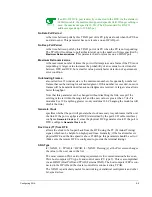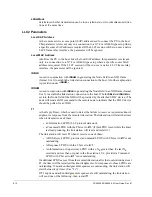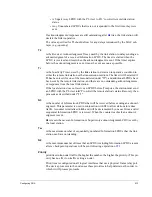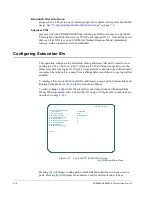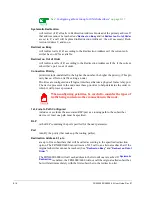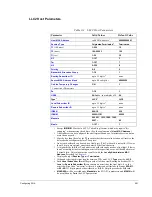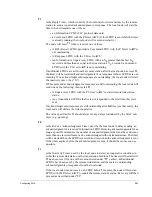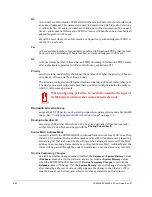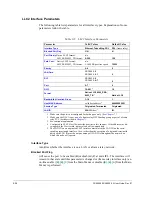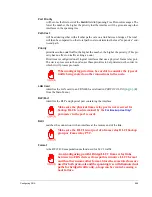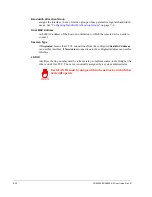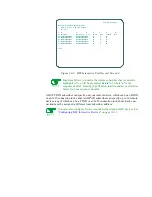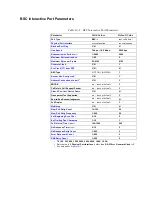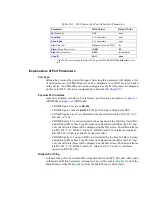
Configuring SNA
9-23
T1
is the Reply Timer, which is used by the local node to detect a failure by the remote
station to send a required acknowledgment or response. The local node will start the
timer when it transmits one of these:
●
an Information LPDU (LLC protocol data unit).
●
a Command LPDU with the P bit set to
B'1.'
(If this LPDU is sent while the timer
is already running, the local node will reset and restart it.)
The node will reset
T1
when it receives one of these:
●
A REJ (Reject) LPDU, provided a Command LPDU with the P bit set to
B'1'
is
not outstanding.
●
A Response LPDU with the F bit set to
B '1.'
●
An Information or Supervisory LPDU with an N
R
greater than the last N
R
received and less than or equal to the line station's V
S
, provided a Command
LPDU with the P bit set to
B'1'
is not outstanding.
If additional LPDUs are set from the remote station after the local node has reset
T1
,
the timer will be restarted if acknowledgments of or responses to those LPDUs are out-
standing. If no acknowledgments/responses are outstanding, the local node will start
the inactivity timer. (See "
Ti
.
")
If
T1
expires and acknowledgments/responses are still outstanding, the local node will
send one of the following, then restart
T1
:
●
A Supervisory LPDU with the P bit set to
B'1,'
to solicit remote link station
status.
●
Any Unnumbered LPDUs that were not responded to the first time they were
sent.
If acknowledgments/responses are still outstanding after
N2
tries (see that entry), the
local node will declare the link inoperative.
The value specified for
T1
should allow for any delays introduced by the MAC sub-
layer (e.g., queuing).
T2
is the Receive Acknowledgment Timer, used by the local node to delay sending an
acknowledgment of a received Information LPDU. Delaying acknowledgments for as
long as possible minimizes the number of acknowledgments that must be sent (since
more than one received frame can be acknowledged with one transmission). The timer
will be started when the LPDU is received and reset when the acknowledgment is sent.
If the timer expires before the acknowledgment is sent, it should be sent as soon as
possible.
Ti
is the Inactivity Timer, used by the local node to detect an inoperative condition in
either the remote link station or the transmission medium. The timer will be started if
T1
has been reset (for one of the reasons listed under "
T1
" earlier), and additional
LPDUs have been sent by the remote link station, and there are no outstanding
acknowledgments or responses from the local node.
If the local node does not receive an LPDU before
Ti
expires, the node will send an
LPDU with the P bit set to
B'1'
to solicit the remote station's status. Recovery will then
proceed as described under "
T1
.
"
Summary of Contents for Netlink FRX4000
Page 2: ......
Page 16: ...xiv FRX4000 FRX6000 4 0 User Guide Rev 01 ...
Page 17: ...Section I Getting Started ...
Page 18: ......
Page 24: ......
Page 37: ...Section II Configuration ...
Page 38: ......
Page 52: ......
Page 78: ......
Page 106: ...7 24 FRX4000 FRX6000 4 0 User Guide Rev 01 ...
Page 142: ...8 36 FRX4000 FRX6000 4 0 User Guide Rev 01 ...
Page 186: ......
Page 216: ......
Page 266: ......
Page 273: ...Section III Operation ...
Page 274: ......
Page 296: ......
Page 324: ......
Page 376: ......
Page 377: ...Section IV Appendices ...
Page 378: ......
Page 384: ......
Page 390: ......
Page 396: ......
Page 400: ......
Page 405: ...Menu Structure E 5 ...
Page 406: ...E 6 FRX4000 FRX6000 4 0 User Guide Rev 01 ...
Page 425: ......
Page 426: ......

